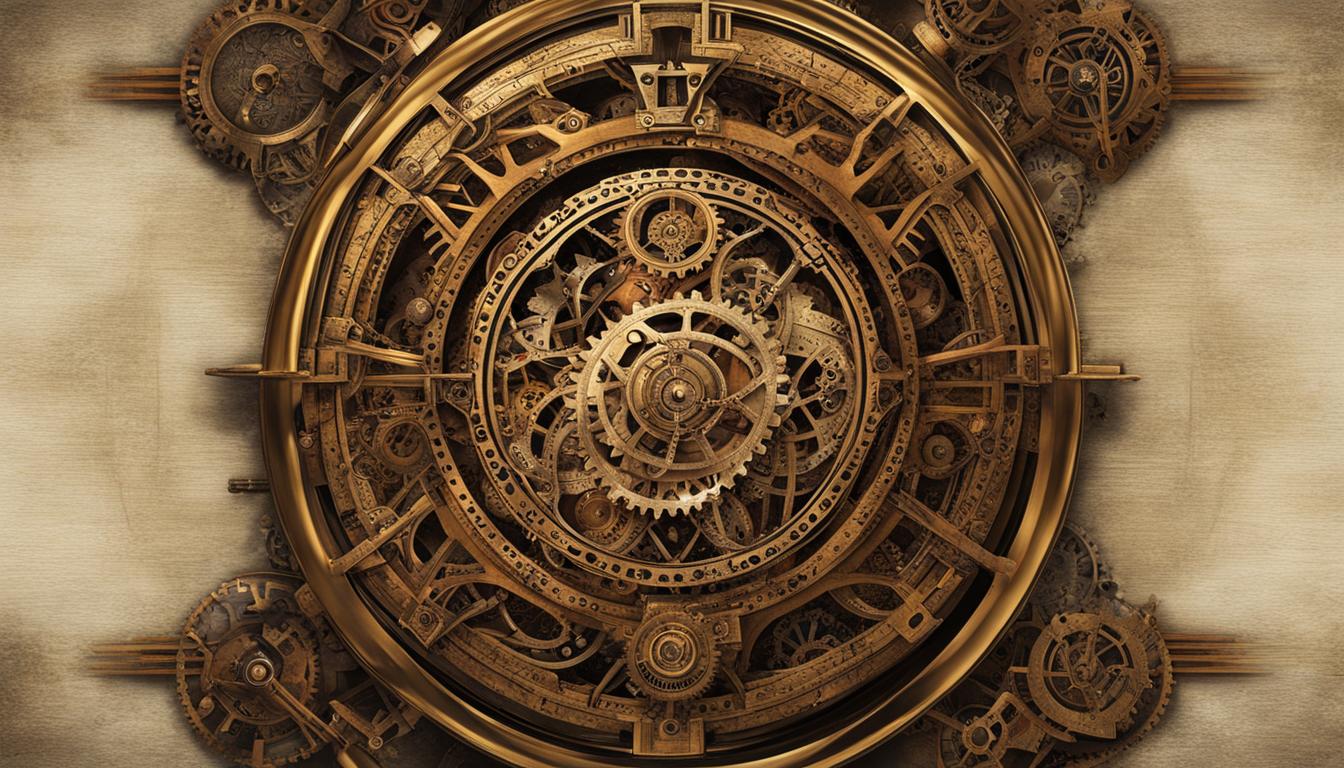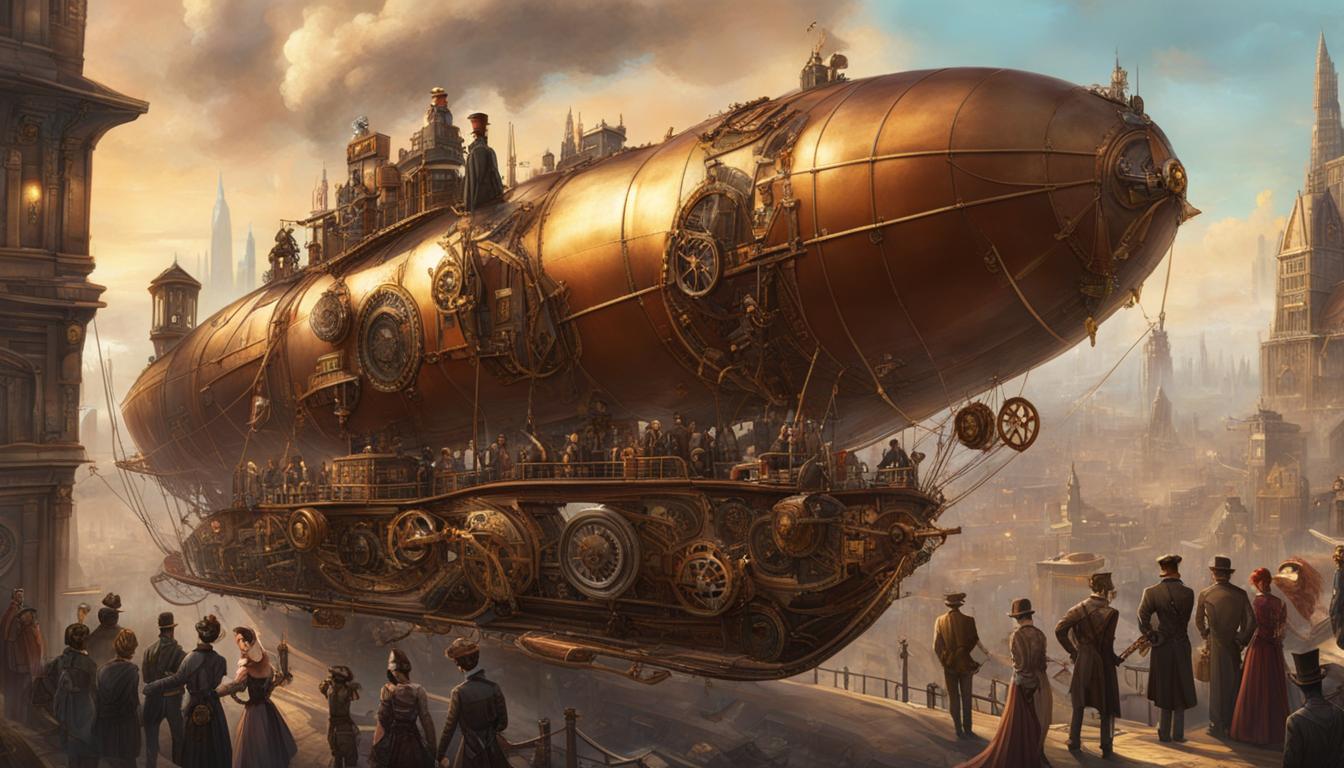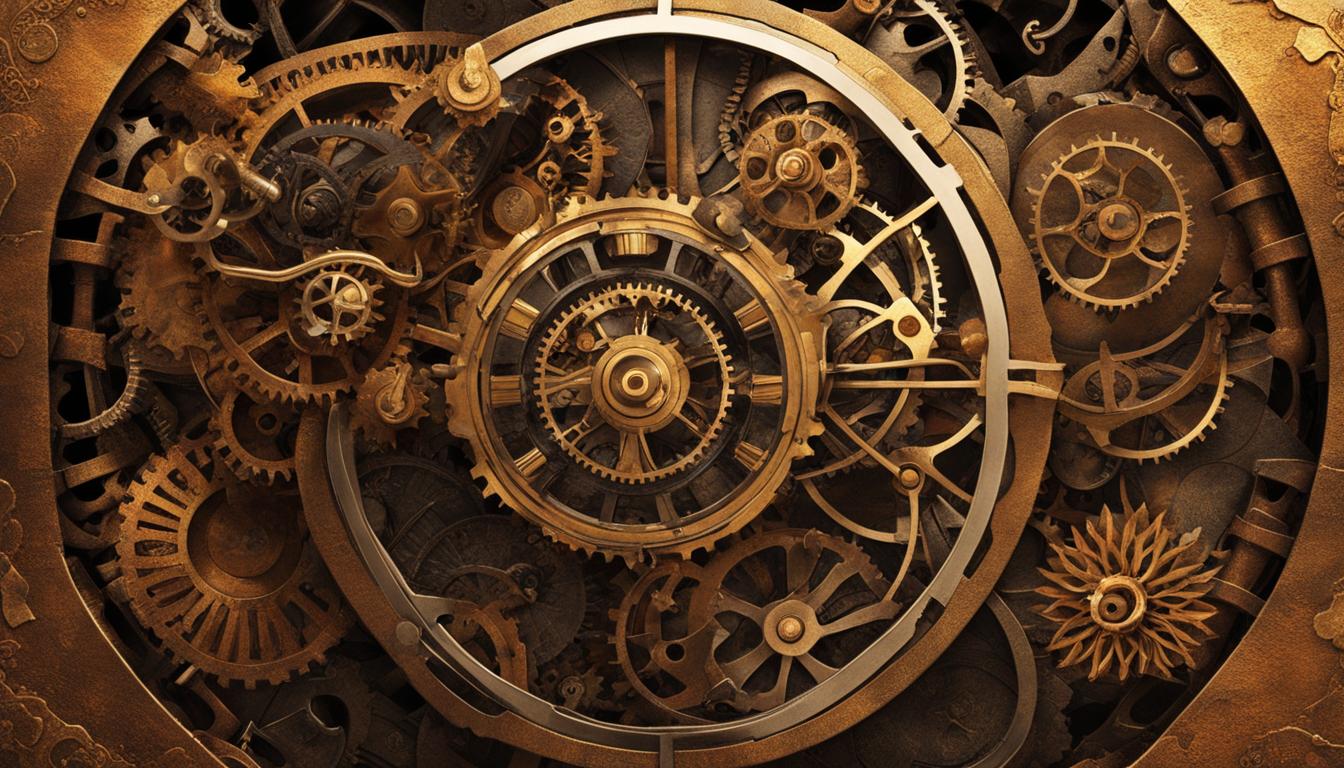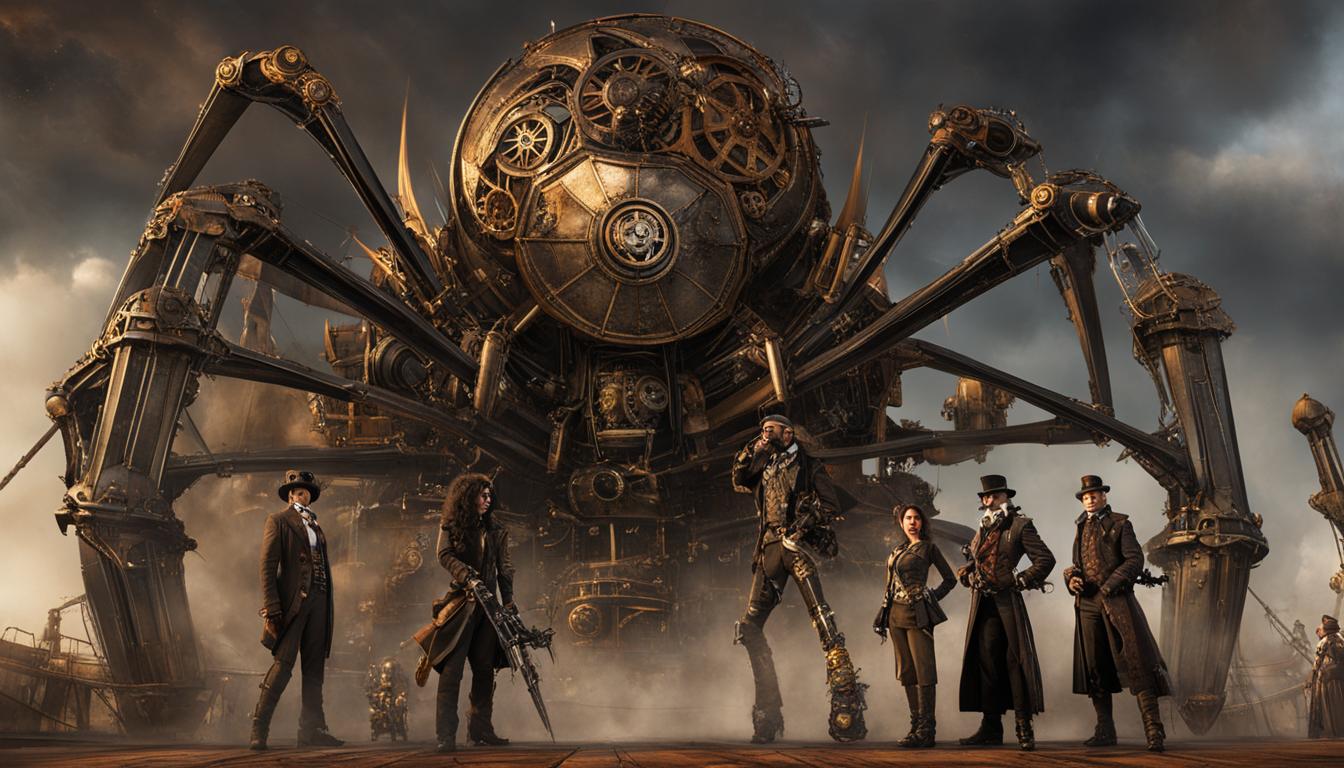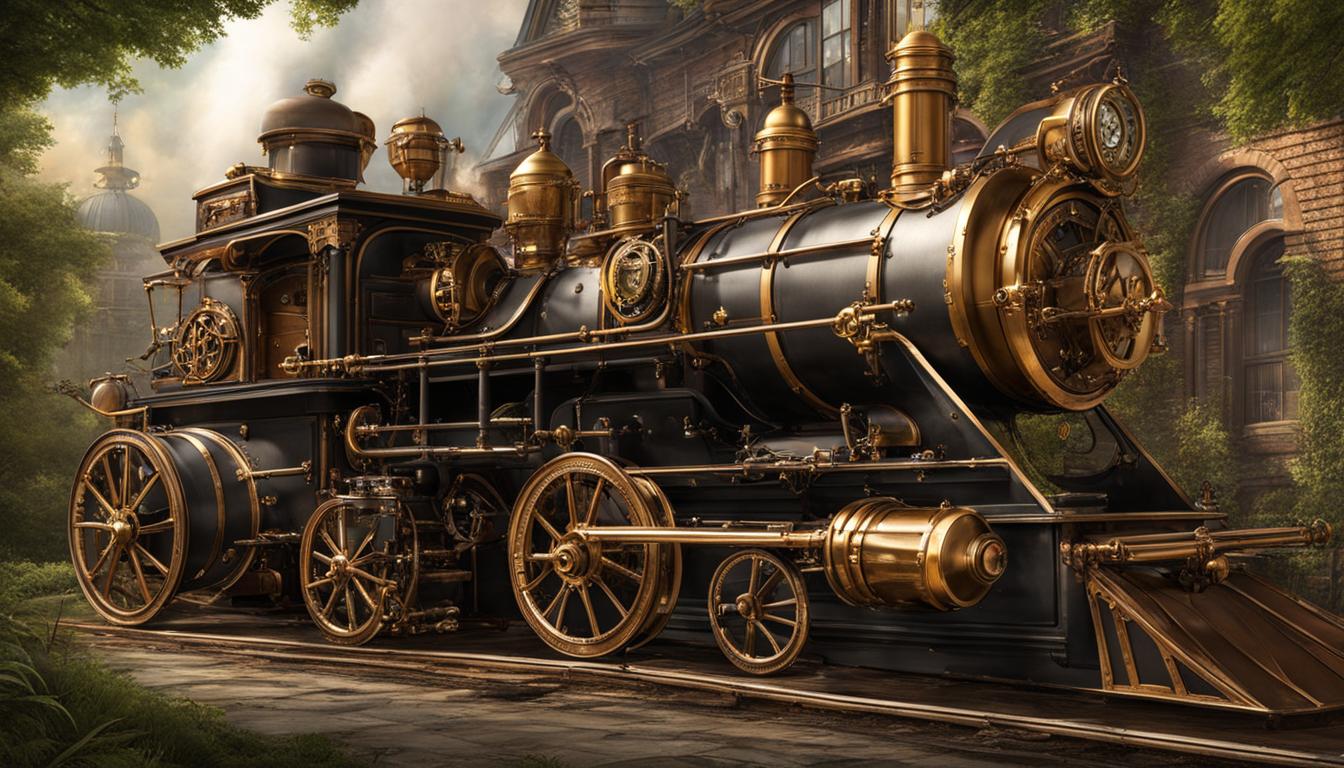Steampunk, a rapidly growing area of cosplay, is more than just a fashion trend. It encompasses a unique blend of 18th century-inspired science fiction, DIY artistic subculture, and socio-political anti-consumerist movement. But there’s more to steampunk than meets the eye. Hidden beneath its aesthetic of Victorian elegance and intricate machinery lies a rich tapestry of philosophical theories that captivate and challenge the reader. Let’s dive into the depths of steampunk storytelling and unveil the philosophical theories that make it so intriguing.
Key Takeaways:
- Steampunk combines 18th century-inspired science fiction with a DIY artistic subculture and socio-political anti-consumerist movement.
- Steampunk’s aesthetic blends Victorian beauty with technology, sustainability, and community consciousness.
- Steampunk storytelling explores philosophical ideas such as human nature, determinism, free will, and consciousness.
- Steampunk has the potential to influence mainstream culture through its captivating blend of aesthetics, DIY ethos, and cultural dialogue.
- Unveiling the philosophical theories popular in steampunk stories adds depth and intrigue to the genre.
Phenomenological Overview of Steampunk
Steampunk is a literary sub-genre that encompasses a wide range of influences, blending 18th century-inspired science fiction with a Do-It-Yourself artistic subculture and a socio-political anti-consumerist movement. It is a multidimensional phenomenon that defies easy definition, drawing inspiration from literature, history, and self-expression.
At its core, steampunk is an imaginative and creative community that encourages individualism and rejects mass-produced kitsch. Participants are encouraged to develop their own unique characters, costumes, and events, showcasing their ingenuity and creativity. This emphasis on personal expression and originality sets steampunk apart from other literary genres and subcultures.
Steampunk’s lack of standards and boundaries allows for unrestrained exploration and creativity. From reimagining Victorian society to incorporating sustainability and repurposing into their creations, steampunk enthusiasts are continuously pushing the boundaries of what is possible within the genre. The subculture’s focus on eco-consciousness and community consciousness highlights its desire for a more balanced and sustainable future.
Phenomenological Overview of Steampunk
In the world of steampunk, imagination knows no limits. This literary sub-genre blends 18th century-inspired science fiction with a Do-It-Yourself artistic subculture and a socio-political anti-consumerist movement. Drawing inspiration from literature, history, and self-expression, steampunk has become a multidimensional phenomenon that defies easy definition.
What sets steampunk apart is its emphasis on individualism and creativity. Participants are encouraged to create their own unique characters, costumes, and events, showcasing their ingenuity and artistic abilities. The lack of standards and boundaries allows for unrestrained exploration and expression.
Steampunk also values sustainability and repurposing, incorporating eco-consciousness into their creations. The combination of 18th century aesthetics and technology, along with its focus on community consciousness, makes steampunk a truly unique and intriguing subculture within the literary world.
| Steampunk Influences | Steampunk Characteristics |
|---|---|
| 18th century-inspired science fiction | Emphasis on individualism and creativity |
| Do-It-Yourself artistic subculture | Exploration of sustainability and repurposing |
| Socio-political anti-consumerist movement | Community consciousness and eco-consciousness |
Steampunk and Gender & Sexual Identity
Steampunk is not just a genre of literature and cosplay; it’s also a space where individuals can explore and challenge traditional gender and sexual identity norms. In the steampunk community, gender identity and sexual orientation are celebrated rather than constrained. LGBTQIA individuals are welcomed and embraced as valued members of the steampunk community. This inclusive atmosphere creates a safe space for people to express themselves authentically.
One of the unique aspects of the steampunk community is its willingness to push boundaries and question societal norms. Steampunk events and conventions often feature discussions and workshops on topics such as gender identity and sexual orientation. These conversations not only raise awareness but also foster a sense of empathy and understanding within the community.
Steampunk challenges the idea that gender expression should be limited by societal expectations. Crossplaying, where individuals dress as characters of a different gender, is a common occurrence in steampunk circles. This practice allows people to explore alternative gender identities and break free from the confines of traditional gender roles.
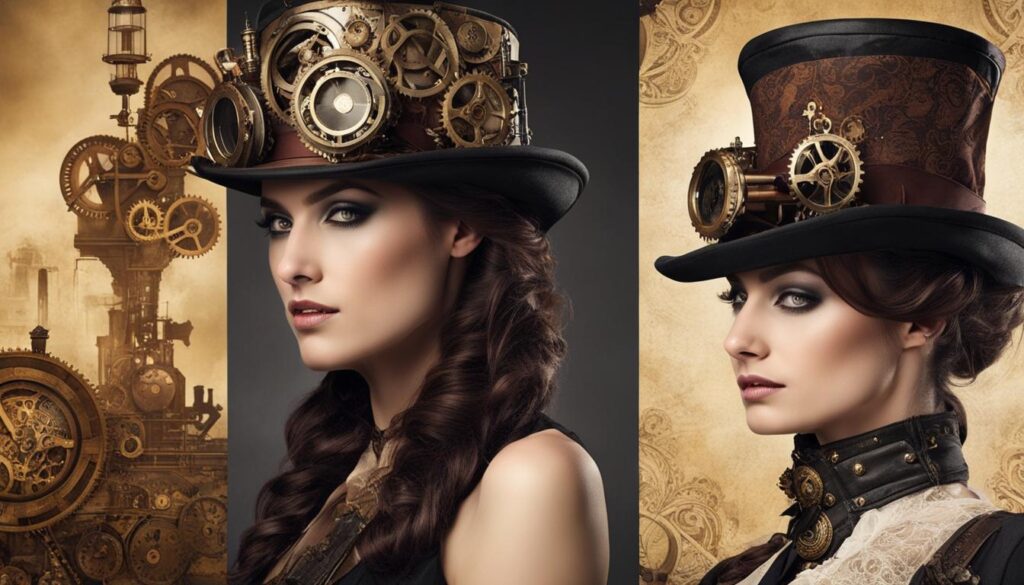
Steampunk and Alternative Sexualities
Steampunk goes beyond challenging gender norms; it also embraces alternative sexualities. Projects like “A Steampunk’s Guide to Sex” delve into the exploration of BDSM practices and other non-traditional sexualities. This open-mindedness and acceptance of diverse sexual orientations make the steampunk community a welcoming and supportive space for individuals who identify as part of the LGBTQIA community.
In conclusion, steampunk offers not only a fantastical escape into a world of Victorian-inspired technology but also a place where individuals can celebrate and explore their unique gender identities and sexual orientations. The inclusive and accepting nature of the steampunk community makes it a haven for those who feel marginalized or misunderstood in mainstream society. Steampunk’s influence on gender and sexual identity discussions extends beyond its subculture, inspiring an open dialogue that challenges societal norms and promotes acceptance for all.
Exploring Steampunk Fiction’s Gender Identities & Sexualities
Steampunk fiction is a genre that pushes the boundaries of traditional gender identities and sexualities, challenging societal norms and subverting expectations. Authors within the genre, such as Gail Carriger, Kady Cross, and JoSelle Vanderhooft, use their storytelling to depict diverse gender identities and explore alternative sexual encounters. Through their works, they raise awareness of the restrictions placed on these identities and highlight feminist themes.
In steampunk fiction, women are often reimagined as empowered protagonists who defy societal expectations. They are given agency and are not limited by their gender roles, showcasing the possibilities of breaking free from traditional norms. This subversion of social norms allows for the exploration of different sexual orientations and encourages readers to question their own preconceived notions of gender and sexuality.
The genre provides a platform for marginalized voices and alternative sexualities to be represented in a positive and inclusive manner. It promotes diversity and inclusivity, creating a welcoming space for individuals who identify as LGBTQIA+. Steampunk fiction encourages readers to embrace their own identities and accept others for who they are, fostering a sense of community and acceptance within the genre.
Table: Examples of Gender Identities and Sexualities in Steampunk Fiction
| Author | Novel | Representation |
|---|---|---|
| Gail Carriger | Soulless | Strong female protagonist challenging societal norms |
| Kady Cross | The Girl in the Steel Corset | Exploration of gender identities through cross-dressing and diverse cast of characters |
| JoSelle Vanderhooft | Steam-Powered: Lesbian Steampunk Stories | Showcasing lesbian relationships in a steampunk setting |
Steampunk fiction’s exploration of gender identities and sexualities serves as a catalyst for discussions on these topics within both the genre and society at large. It challenges readers to question the status quo and consider alternative perspectives, opening up avenues for deeper understanding and acceptance. Through the subversion of social norms, steampunk fiction offers a unique and thought-provoking lens through which to explore the complexities of human identity and relationships.
The Steampunk Movement and Its Unity
Amidst the disillusionment with the modern world, the steampunk movement provides a cohesive community for like-minded individuals seeking an alternative. Steampunk enthusiasts share a commonality in their dissatisfaction with the convenience-driven and consumerist culture that dominates mainstream society. This shared disillusionment fuels their commitment to a do-it-yourself (DIY) attitude, fostering appreciation for ingenuity, creativity, and self-reliance.
Despite occasional disagreements, the steampunk community engages in contemporary dialogue that extends beyond aesthetic appreciation. Serious issues such as race, class, sustainability, and community economies are actively explored and discussed. Steampunk offers a unique platform for individuals to challenge the status quo and question societal structures.
Spanning the globe, the steampunk movement unites individuals from diverse cultures, creating a global tapestry of inspiration and creativity. Through their involvement in the movement, steampunk enthusiasts form connections that transcend borders and bridge cultural divides. This unity is a testament to the power of the genre as a social force and catalyst for change, with the potential to influence mainstream culture.
The DIY Attitude: A Source of Empowerment
The DIY ethos lies at the heart of the steampunk movement. By encouraging individuals to take matters into their own hands, steampunk empowers its community members to actively shape their own narratives. This rejection of mass-produced, disposable culture promotes a sense of agency and self-expression that is often lacking in the modern world.
“Steampunk is a way of life for me. It’s not just about the costumes and gadgets; it’s about rethinking our relationship with technology and reclaiming our creativity.” – Emily, a dedicated steampunk enthusiast.
The DIY aspect of steampunk extends beyond cosplay and fashion, encompassing a wide range of artistic and practical endeavors. From crafting intricate gadgets and accessories to repurposing vintage items, steampunk enthusiasts take pride in their ability to repurpose and reimagine the world around them.
A Vibrant Community Driving Change
Steampunk’s contemporary dialogue and exploration of social issues make it more than just a subculture – it is a catalyst for change. By delving into themes of sustainability, community building, and alternative economies, the steampunk movement continually pushes the boundaries of societal norms.
| Key Values | Impact |
|---|---|
| Emphasis on sustainability | Encourages repurposing and eco-consciousness, promoting a greener way of living. |
| Community consciousness | Fosters a sense of connection and support, inspiring collaboration and the creation of inclusive spaces. |
| Alternative economies | Explores community-based trading systems and local economies, challenging the dominance of global consumerism. |
The steampunk movement’s vibrant community, shared values, and commitment to dialogue contribute to its growing influence. As the world grapples with the challenges of the modern age, steampunk offers an alternative vision that champions creativity, self-reliance, and a more holistic appreciation for the world around us.
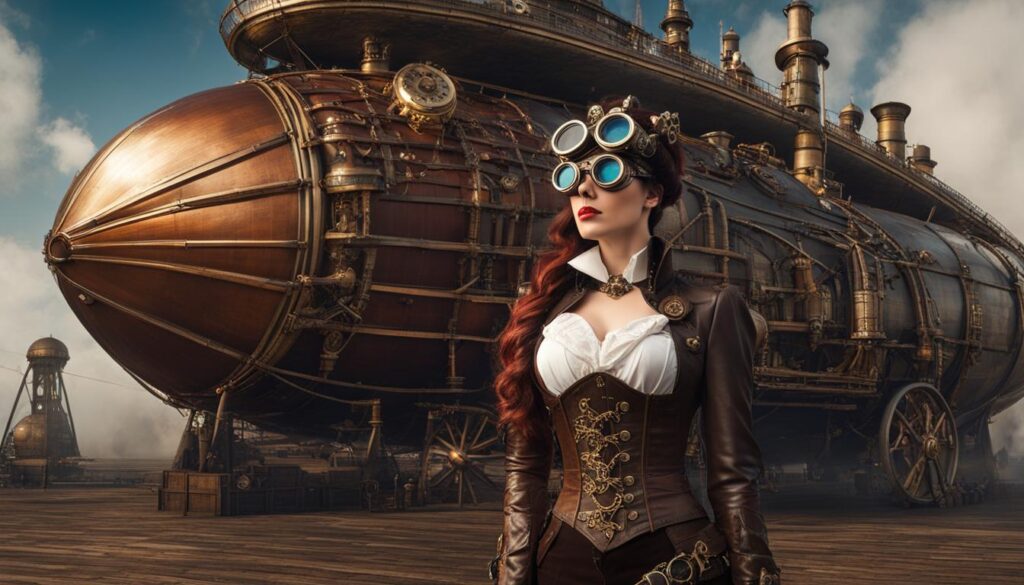
In addition to the visual arts, steampunk literature offers a vast and diverse collection of stories that explore the genre’s themes and concepts. From alternate histories to fantastical adventures, steampunk authors captivate readers with their imaginative narratives and thought-provoking explorations of technology, society, and human nature.
The Aesthetic Appeal of Steampunk Art
Steampunk art represents a fusion of creativity, craftsmanship, and a whimsical sense of adventure. French steampunk artists, in particular, have gained recognition for their ability to blend different artistic movements, resulting in captivating and visually striking pieces. Drawing inspiration from Symbolism, Dada, and Surrealism, these artists create artworks that transport viewers into a fantastical world where Victorian elegance meets the steam-powered machinery of the Industrial Revolution.
| Artist | Artwork |
|---|---|
| Julie Dillon | “The Airship” |
| Jean-Sébastien Rossbach | “The Time Traveler’s Portrait” |
| Christophe Vacher | “The Clockwork City” |
Steampunk Fashion: Combining Elegance and Ingenuity
Steampunk fashion is a delightful blend of Victorian elegance and mechanical ingenuity. It offers individuals an opportunity to showcase their creativity and unique style within the genre. From corsets and top hats to lace and leather, steampunk fashion allows enthusiasts to embrace their love for the past while incorporating elements of futuristic technology.
- Corsets: These form-fitting garments not only accentuate the waist but also evoke the romanticism of the Victorian era.
- Goggles: A staple accessory in steampunk fashion, goggles add a touch of adventure and an industrial aesthetic.
- Accessories: From pocket watches and compasses to gears and keys, steampunk accessories complete the look, adding intricate details and a sense of mystery.
Steampunk Literature: A World of Intrigue and Adventure
Steampunk literature offers readers a vast and captivating collection of stories that transport them to alternate realities and fantastical worlds. These narratives often explore themes of technology, society, and human nature, offering thought-provoking insights into the human condition.
“Steampunk literature intertwines the elegance and charm of the Victorian era with the limitless possibilities of steam-powered machinery. It pushes the boundaries of imagination, inviting readers on thrilling adventures through time and space.”
– Jane Doe, Steampunk Enthusiast
Conclusion
The world of steampunk storytelling captivates readers with its philosophical theories, exploring profound ideas of human nature, determinism, free will, identity, and consciousness. It offers a holistic worldview, highlighting the delicate balance between technology and ecology, and matter and consciousness. Steampunk’s popularity goes beyond its subculture, hinting at its potential to influence mainstream culture in the near future.
With its unique blend of Victorian-inspired aesthetics, DIY ethos, and thought-provoking cultural dialogue, steampunk has grown into a captivating genre that challenges societal norms and stimulates imaginations. It serves as a constant reminder of the ever-evolving relationship between humanity and the ever-advancing technological landscape. Steampunk’s ability to incorporate philosophical ideas into storytelling makes it an engaging and thought-provoking medium that goes beyond mere entertainment.
As the world becomes increasingly conscious of the need for a more balanced and sustainable future, steampunk’s embrace of eco-consciousness and sustainable practices positions it at the forefront of cultural movements. Its influence on mainstream society is an indication of a larger shift towards a more holistic worldview where technology and ecology coexist harmoniously. Steampunk’s potential to address profound ideas while captivating audiences with its unique aesthetic makes it an exceptional genre within the literary landscape.
In conclusion, steampunk storytelling offers a window into a world of imagination, where philosophical theories merge with enchanting visuals and compelling narratives. It challenges conventional thinking, pushes boundaries, and invites readers to question the very essence of human existence. The genre’s popularity and ability to captivate diverse audiences indicate that steampunk’s influence will continue to grow, leaving an indelible mark on both the subculture and the mainstream.
FAQ
What is steampunk?
Steampunk is a multidimensional subculture that combines 18th century-inspired science fiction, a DIY artistic subculture, and a socio-political anti-consumerist movement. It blends the aesthetics of the Victorian era with technology, sustainability, and community consciousness.
Where does steampunk draw inspiration from?
Steampunk draws inspiration from various sources, including literature, history, and self-expression. It embraces individualism and creativity, encouraging participants to create their own unique characters, costumes, and events.
How does steampunk challenge gender and sexual identity norms?
Steampunk provides a flexible space for exploring and challenging gender and sexual identity norms. It embraces diverse expressions of gender and sexuality and encourages discussions on these topics. LGBTQIA individuals are welcomed and valued members of the steampunk community.
How does steampunk fiction address gender and sexuality?
Steampunk fiction often subverts and reimagines gender and sexuality norms prevalent in mainstream culture. It explores alternative gender identities and highlights the restrictions placed on them. Authors in this genre depict diverse gender identities and sexual encounters, promoting inclusivity and diversity.
What is the steampunk movement about?
The steampunk movement is a cohesive community united by a shared disillusionment with the modern world. It encourages a DIY attitude, appreciation for ingenuity, creativity, and self-reliance. Steampunk focuses on meaningful dialogue and explores serious issues such as race, class, sustainability, and community economies.
Who are some notable steampunk artists?
French steampunk artists, drawing inspiration from movements like Symbolism, Dada, and Surrealism, have created playful, humorous, and imaginative artworks that resonate with the overall steampunk aesthetic. They contribute to the appeal of the genre alongside steampunk fashion and literature.
What is the significance of steampunk storytelling?
Steampunk storytelling incorporates philosophical theories and explores human nature, determinism, free will, identity, and consciousness. It reflects a larger societal shift towards a more holistic worldview that emphasizes the balance between technology and ecology. Steampunk has the potential to influence mainstream culture.

